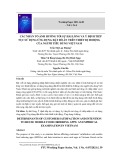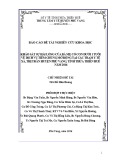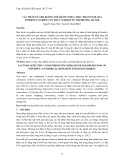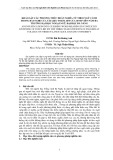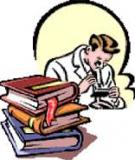
How Much Does Household Collateral
Constrain Regional Risk Sharing?
Hanno Lustig∗
UCLA and NBER
Stijn Van Nieuwerburgh†
New York University Stern School of Business
August 4, 2005
Abstract
The covariance of regional consumption varies cross-sectionally and over time.
Household-level borrowing frictions can explain this aggregate phenomenon. When
the value of housing falls, loan collateral shrinks, borrowing (risk-sharing) declines,
and the sensitivity of consumption to income increases. Using panel data from 23
US metropolitan areas, we find that in times and regions where collateral is scarce,
consumption growth is about twice as sensitive to income growth. Our model aggre-
gates heterogeneous, borrowing-constrained households into regions characterized by a
common housing market. The resulting regional consumption patterns quantitatively
match the data.
∗corresponding author: email:hlustig@econ.ucla.edu, Dept. of Economics, UCLA, Box 951477 Los An-
geles, CA 90095-1477
†email: svnieuwe@stern.nyu.edu, Dept. of Finance, NYU, 44 West Fourth Street, Suite 9-120, New York,
NY 10012. First version May 2002. The material in this paper circulated earlier as ”Housing Collateral and
Risk Sharing Across US Regions.” (NBER Working Paper). The authors thank Thomas Sargent, David
Backus, Dirk Krueger, Patrick Bajari, Timothey Cogley, Marco Del Negro, Robert Hall, Lars Peter Hansen,
Christobal Huneuus, Matteo Iacoviello, Patrick Kehoe, Martin Lettau, Sydney Ludvigson, Sergei Morozov,
Fabrizio Perri, Monika Piazzesi, Luigi Pistaferri, Martin Schneider, Laura Veldkamp, Pierre-Olivier Weill,
and Noah Williams. We also benefited from comments from seminar participants at NYU Stern, Duke,
Stanford GSB, University of Iowa, Universit´e de Montreal, University of Wisconsin, UCSD, LBS, LSE,
UCL, UNC, Federal Reserve Bank of Richmond, Yale, University of Minnesota, University of Maryland,
Federal Reserve Bank of New York, BU, Wharton, University of Pittsburgh, Carnegie Mellon University
GSIA, Kellogg, University of Texas at Austin, Federal Reserve Board of Governors, University of Gent,
UCLA, University of Chicago, Stanford, the SED Meeting in New York, and the North American Meeting
of the Econometric Society in Los Angeles. Special thanks to Gino Cateau for help with the Canadian
data. Stijn Van Nieuwerburgh acknowledges financial support from the Stanford Institute for Economic
Policy research and the Flanders Fund for Scientific Research. Keywords: Regional risk sharing, housing
collateral JEL F41,E21
1

1 Introduction
The cross-sectional correlation of consumption in US metropolitan areas is much smaller
than the correlation of labor income or output. This quantity anomaly has been docu-
mented in international (e.g. Backus, Kehoe and Kydland (1992), and Lewis (1996)) and
in regional data (e.g. Atkeson and Bayoumi (1993), Hess and Shin (2000) and Crucini
(1999)), but these unconditional moments hide a surprising amount of time variation in
the correlation of consumption across US metropolitan areas. This novel dimension of the
quantity anomaly is the focus of our paper, and we propose a housing collateral mechanism
to explain it.
On average, US regions share only a modest fraction of total region-specific income risk.
But at times this fraction is much higher than at other times: between 1975 and 1985, the
ratio of the regional cross-sectional consumption to income dispersion, a standard measure
of risk sharing, decreased by fifty percent, while it doubled between 1987 and 1992. This
stylized fact presents a new challenge to standard models, because it reveals that the
departures from complete market allocations vary substantially over time.
Conditioning on a measure of housing collateral helps to understand this aspect of the
consumption correlation puzzle, both over time and across different regions. In the data,
our measure of housing collateral scarcity broadly tracks the variation in this regional
consumption-to-income dispersion ratio. This ratio is twice as high relative to its lowest
value when collateral scarcity is at its highest value in the sample. According to our
estimates, the fraction of regional income risk that is traded away, more than doubles
when we compare the lowest to the highest collateral scarcity period in postwar US data.
We find cross-sectional evidence for the housing collateral mechanism as well. Using
regional measures of the housing collateral stock to sort regions into bins, we find that
the income elasticity of consumption growth for regions in the lowest housing collateral
quartile of US metropolitan areas is more than twice the size of the same elasticity for
areas in the highest quartile, and their consumption growth is only half as correlated with
aggregate consumption growth.
We propose an equilibrium model of household risk sharing that replicates these find-
ings. In the model, households share risk only to the extent that borrowing is collateralized
by housing wealth. This modest friction is a realistic one for an economy like the US. A
key implication of the model is that the degree of risk sharing should vary over time and
with the housing collateral ratio. Our emphasis on housing, rather than financial assets,
reflects three features of the US economy: the participation rate in housing markets is very
high (2/3 of households own their home), the value of the residential real estate makes
up over seventy-five percent of total assets for the median household (Survey of Consumer
Finances, 2001), and housing is a prime source of collateral.1
1To keep the model as simple as possible, we abstract from financial assets or other kinds of capital
(such as cars) that households may use to collateralize loans. 75 percent of household borrowing in the
1

Our model reproduces the quantity anomaly. The key is to impose borrowing con-
straints at the household level and then to aggregate household consumption to the re-
gional level. First, the household constraints are much tighter than the constraints faced
by a stand-in agent at the regional level. Second, because the idiosyncratic component of
household income shocks are more negatively correlated within a region than the equilib-
rium household consumption changes that result from these shocks, aggregation produces
cross-regional consumption growth dispersion that exceeds regional income growth disper-
sion. In addition, a reduction in the supply of housing collateral tightens the household
collateral constraints, causing regional consumption growth to respond more to regional
income shocks. As a result, when we run the same consumption insurance tests on the
model’s regional consumption data, we replicate the variation in the income elasticity of
regional consumption growth that we document in the data.
Our model offers a single explanation for the apparent lack of consumption insurance
at different levels of aggregation.2Our approach differs from that in the literature on
international risk sharing, which adopts the representative agent paradigm. That literature
typically relies on frictions impeding the international flow of capital resulting from the
government’s ability to default on international debt or to tax capital flows (e.g. Kehoe
and Perri (2002)), or resulting from transportation costs (e.g. Obstfeld and Rogoff (2003)).
Such frictions cannot account for the lack of risk sharing between regions within a country
or between households within a region. This paper shows that modest frictions at the
household level in a model with heterogenous agents within a region or country can better
our understanding of important macro puzzles.
This paper is not about a direct housing wealth effect on regional consumption: For an
average unconstrained household that is not about to move, there is no reason to consume
more when its housing value increases, simply because it has to live in a house and consume
its services (see Sinai and Souleles (2005) for a clear discussion). We find no evidence in
regional consumption data of a direct wealth effect: Regions consume more when total
regional labor income increases and this effect is larger when housing wealth is smaller
relative to human wealth in that region. We test for a separate housing wealth effect
on regional consumption, and we did not find any. In UK data, Campbell and Cocco
(2004) also find evidence in favor of a collateral effect on regional consumption, but only
in aggregate measures of housing wealth. We find direct evidence that regional measures
of housing wealth determine the sensitivity of regional consumption to regional income
shocks, as predicted by the model.
Overview and Related Literature Section 2 describes a new data set of the largest
US metropolitan statistical areas (MSA). Each MSA is a relatively homogenous region
data is collateralized by housing wealth (US Flow of Funds, 2003).
2A large literature documents that household-level consumption data are at odds with complete insurance
as well; for early work see Cochrane (1991) and Mace (1991).
2

in terms of rental price shocks. Since we do not have good data on the intra-regional
time-variation in housing prices, metropolitan areas are a natural choice.3
Section 3 looks at the regional consumption data though the lens of a complete markets
model, with a stand-in agent for each region. We back out regional ‘consumption wedges’
that measure the distance of the data from the complete market allocation. We then relate
the time-series and cross-sectional variation in the amount of housing collateral to the
distribution of regional consumption wedges.
This motivates section 4, which makes contact with the large empirical literature on
risk sharing that tests the null hypothesis of perfect insurance by estimating linear con-
sumption growth regressions (Cochrane (1991), Mace (1991), Nelson (1994), Attanasio and
Davis (1996), Blundell, Pistaferri and Preston (2002), and ensuing work).4In our consump-
tion share growth regressions, the right-hand-side variable is regional income share growth
interacted with the housing collateral ratio; income and consumption shares are income
and consumption as a fraction of the aggregate, and the housing collateral ratio is the ratio
of collateralizeable housing wealth to non-collateralizeable human wealth. The interaction
term captures the collateral effect. Consistent with the regional risk-sharing literature that
uses state level data (Wincoop (1996), Hess and Shin (1998), DelNegro (1998), Asdrubali,
Sorensen and Yosha (1996), Athanasoulis and Wincoop (1998), and DelNegro (2002)), we
reject full consumption insurance among US metropolitan regions.5
More importantly, and new to this literature, we find that collateral scarcity increases
the correlation between income growth shocks and consumption growth. These collateral
effects are economically significant. When the housing collateral ratio is at its fifth per-
centile level, only thirty-five percent of regional income share shocks are insured away. In
contrast, when the housing collateral ratio is at its ninety-fifth percentile level, ninety-two
percent of regional income share shocks are insured away. As a robustness check, we repeat
the analysis for a panel of Canadian provinces, and we find similar variations in the income
elasticity of regional consumption growth associated with fluctuations in housing collateral.
Section 5 adds a regional dimension to the model of Lustig and VanNieuwerburgh
(2004) and investigates its risk-sharing implications. In the model, the effectiveness of the
household risk sharing technology endogenously varies over time due to movements in the
value of housing collateral.6Instead, in Lustig and VanNieuwerburgh (2004), the focus
is on time-variation in financial risk premia. Here, we study a different implication: In
3If housing prices are strongly correlated within a region, there are only small efficiency gains from
looking at household instead of regional consumption data if the objective is to identify the collateral effect.
4Our paper also makes contact with the large literature on the excess sensitivity of consumption to
predictable income changes, starting with Flavin (1981), who interpreted her findings as evidence for bor-
rowing constraints, and followed by Hall and Mishkin (1982), Zeldes (1989), Attanasio and Weber (1995)
and Attanasio and Davis (1996), all of which examine at micro consumption data.
5Asdrubali et al. (1996) find more evidence of risk sharing among regions and states than among coun-
tries.
6Ortalo-Magne and Rady (1998), Ortalo-Magne and Rady (1999) and Pavan (2005) have also developed
models that deliver this feature.
3

times in which collateral is scarce, the model predicts equilibrium consumption growth
to be less strongly correlated across regions. It replicates key moments of the observed
regional consumption and income distribution. First, the average ratio of the cross-sectional
consumption dispersion to income dispersion is larger than one -the quantity anomaly-, and
this ratio increases as collateral becomes scarcer, as in the data. Second, we run the same
consumption growth regressions on model-simulated data, and replicate the results from
the data.
2 Data
We construct a new data set of US metropolitan area level macroeconomic variables, as
well as standard aggregate macroeconomic variables. All of the series are annual for the
period 1951-2002.
2.1 Aggregate Macroeconomic Data
We use two distinct measures of the nominal housing collateral stock HV : the market value
of residential real estate wealth (HV rw ) and the net stock current cost value of owner-
occupied and tenant occupied residential fixed assets (HV fa). The first series is from the
Flow of Funds (Federal Board of Governors) for 1945-2002 and from the Bureau of the
Census (Historical Statistics for the US) prior to 1945. The last series is from the Fixed
Asset Tables (Bureau of Economic Analysis) for 1925-2001. Appendix C provides detailed
sources. HV rw is a measure of the value of residential housing owned by households, while
HV fa which is a measure of the total value of residential housing. Real per household
variables are denoted by lower case letters. The real, per household housing collateral
series hvrw and hvf a are constructed using the all items consumer price index from the
Bureau of Labor Statistics, pa, and the total number of households from the Bureau of
the Census. Aggregate nondurable and housing services consumption, and labor income
plus transfers data are from the National Income and Product Accounts (NIPA). Real
per household labor income plus transfers is denoted by ηa, real per capita aggregate
consumption is ca.
2.2 Regional Macroeconomic Data
We construct a new panel data set for the 30 largest metropolitan areas in the US. The
regions combine for 47 percent of the US population. The metropolitan data are annual
for 1951-2002. Thirteen of the regions are metropolitan statistical areas (MSA). The other
seventeen are consolidated metropolitan statistical areas (CMSA), comprised of adjacent
and integrated MSA’s. Most CMSA’s did not exist at the beginning of the sample. For
consistency we keep track of all constituent MSA’s and construct a population weighted
4


